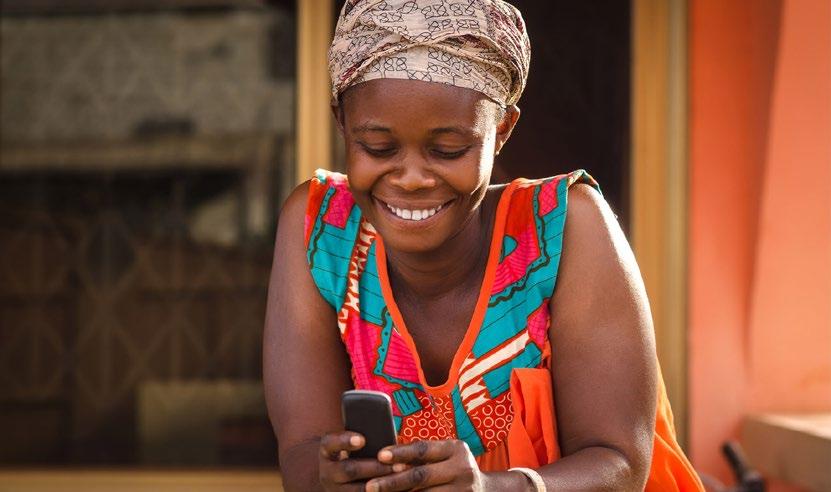
3 minute read
3.2 Mobile enabling access to the internet and life-saving services
Although the mobile broadband coverage gap5 has been significantly reduced due to operator investments, around 450 million people globally still live in areas without access to internet services. Meanwhile, the usage gap6 remains unchanged and is even expanding in some markets; nearly 3.4 billion people are not using mobile internet despite living in areas with mobile broadband coverage. The Covid-19 crisis has reinforced the impacts of the digital divide, with the unconnected less able to mitigate the economic and social disruption to their lives. For many people, mobile networks remain the only form of internet access, underlining the urgency to identify solutions to accelerate mobile internet adoption and use. In 2021, more than 200 million people connected to mobile internet for the first time, bringing the total to 4.19 billion people (53% of the global population). By 2025, this number will rise to 5 billion, equivalent to three in five people globally.
5. The ‘coverage gap’ refers to those living outside of areas covered by mobile broadband networks. 6. The ‘usage gap’ refers to those who live within areas covered by mobile broadband networks but do not yet subscribe to mobile broadband services.
Advertisement
Figure 30 More than 200 million people connected to mobile internet for the first time in 2021, with 53% of the global population in total now connected
State of global mobile internet connectivity by region (percentage of total population)
World 53% 41% 6%
Mobile internet subscribers Covered but do not use the internet Not covered
North America 77% 22% 1%
Europe 79% 20% 1%
CIS 65% 30% 5%
Greater China 71% 28% 1%
Latin America 58% 38% 4%
Source: GSMA Intelligence
Sub-Saharan Africa 28% 53% 19%
MENA 49% 44% 7%
Asia Pacific 44% 51% 5%
Around the world, mobile operators and their partners continue to pursue innovations in network technology and business models to increase access to mobile broadband networks and deliver services more efficiently to unconnected populations. Aerial technologies, such as satellites, could be instrumental in bringing these populations online given the challenge of delivering connectivity in remote areas by conventional means. Over the past year, there has been a wave of partnerships between operators and satellite companies to address the coverage gap that still exists in many rural and remote areas. These include the following: • Deutsche Telekom signed an agreement with
Eutelsat to enable high-speed broadband connectivity in remote parts of Germany. • KDDI announced that it will use SpaceX’s Starlink satellite for internet backhaul in rural areas in
Japan starting from early 2022. • Verizon is collaborating with Amazon’s Project
Kuiper to deliver cellular backhaul solutions to extend the reach of Verizon’s mobile network to remote communities in the US. • Vodacom and Eutelsat have signed an agreement to bring connectivity to underserved regions of
Tanzania. Reducing the internet usage gap is key to closing the digital divide in countries around the world. In practice, this means addressing the main usage barriers of device affordability and lack of literacy and digital skills. Innovation in device offerings is one of several solutions that can help address the different barriers that persist across regions. For example, in India, Reliance Jio unveiled a massmarket smartphone, jointly developed with Google, with financing options to make it accessible for a wider range of consumers.
Global initiative to tackle smartphone affordability barrier
In September 2021, Vodafone Group teamed up with the UN’s International Telecommunication Union (ITU) to launch a multi-stakeholder initiative to address the global mobile internet access gap. The Vodafone CEO and ITU secretary-general serve as co-chairs of the new Broadband Commission Working Group on increasing access to smartphones. The goal is to address issues of device affordability, which limit internet access, by identifying political, commercial and economic interventions to increase smartphone access. The new Broadband Commission Working Group, which includes the GSMA, has been tasked to identify interventions to help achieve “Smartphones for All” by 2030. Much of its focus will be on low- and middle-income countries, which account for more than 90% of the world’s unconnected population. However, there also remains a significant digital inclusion gap in high-income countries. Operators in these markets are making efforts to address this. For example, in the US, Verizon is expanding its initiative to provide wireless broadband to underserved communities, while in France, Orange is running workshops in its stores to provide free group lessons on smartphone use and digital skills.



